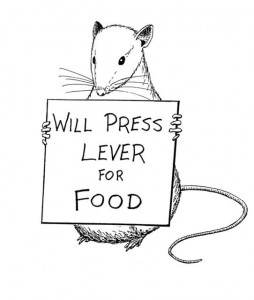
Behaviorist Learning Theory
How does learning occur?
Behaviorism focuses on observable events that influence learning. The occurrence of learning is based on responses to various stimuli during the learning process. Learning occurs when the appropriate response is triggered by a particular environmental stimulus. Rather than emphasizing thoughts and emotions, behaviorist theory focuses on behavioral actions (Standridge, 2001).
What factors influence learning?
Environmental factors have the biggest influence on learning. A key environmental factor is the use of rewards and punishments. Based on Skinner’s theory of operant conditioning, punishment-rewards systems can be used to increase desirable behavior or decrease undesirable behavior by using reinforcement or punishments (Ormrod, et al., 2008). According to Standridge (2001), Educators can consciously or unconsciously condition satisfying learner responses through the use of positive and negative reinforcement, verbal cueing, and by modeling the desired behavior.
What is the role of memory?
Looking through the behavioral lens, memory is based on the formation of habits after recurring experiences (Davis, et al., 2008). The use of punishment and rewards can shape the likelihood that learners develop and remember particular habits. The role of memory in behaviorist theory does not focus on storage and retrieval as emphasized in cognitivist theory.
How does transfer occur?
Transfer involves both the factors that influence learning (stimulus and response) and memory of the habits formed based on these environmental factors. With these elements working together, behavior can transfer across learning situations that have common characteristics. For example, the process of classification can be applied to a number of learning contexts that share the same features (Ertmer & Newby, 1993).
What types of learning are best explained by behaviorist theory?
Task-oriented learning is a major component of behaviorism. Some examples of task-oriented learning activities include:
There is a helpful presentation created by Klaus Leonhardt (2003) that discusses the importance of the task-based learning framework. Click on the following link to view this presentation: Leonhardt Presentation.
Ertmer and Newby (1993) claim that reinforcement, instructional cues and practice are great ways to facilitate task-oriented activities, such as those listed above, while also building and strengthening stimulus response associations.
How is technology used for learning in the teaching field?
There are many online quiz programs, practice activities, and educational games that instantly assess a learner’s knowledge. The key component of this educational technology is that these software programs or websites provide students with immediate feedback and praise if students provide the correct answer, or further review if an incorrect answer is provided. For example, MyMaxScore is an ACT prep program that gives instant and detailed feedback to students explaining the concept covered in each question and any rules or processes that apply to the concept at hand. Memorizing rules and processes will allow students to transfer conceptual knowledge across a variety of contexts and disciplines.